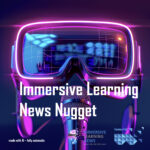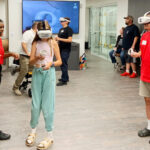Delve deeper to uncover the myriad benefits of virtual training solutions.
Virtual reality has become a vital asset for employee development in diverse sectors. Its utilization in training has demonstrated remarkable effectiveness, rendering learning more immersive, economically viable, and temporally efficient. Integrating VR training solutions into your organizational framework requires careful planning and execution. Organizations should define their training objectives, choose the proper hardware and software, design engaging training content, and provide adequate support and training for learners.
By embracing VR technology, organizations can stay ahead of the curve and empower their employees with cutting-edge training experiences. This article aims to furnish insight into VR training solutions by showing their advantages, presenting instances of VR training modules, and offering guidance on integrating VR training solutions into your organizational framework. Delve deeper to uncover the myriad benefits of virtual training solutions.
What Is Virtual Reality Training, and Why Do You Need It?
Virtual reality training involves using VR technology to deliver educational content or training materials, rather than traditional classroom settings. This method immerses participants in a three-dimensional environment where they can interact with virtual elements in real-time. Training can be conducted synchronously, with all participants experiencing and interacting within the same virtual space simultaneously, providing a highly engaging and interactive learning experience that goes beyond standard video conferencing or online meeting rooms.
Virtual reality training solutions can be asynchronous, allowing individuals to progress through the material at their own pace and convenience within specified time limits. From online workshops and tutorials to interactive demonstrations and skills assessments, virtual reality training offers a versatile approach to educating users on various topics. This flexibility enables customization to suit different learning needs and target specific niches effectively. Why choose VR training? Implementing this training strategy offers numerous benefits for instructors and learners.
Advantages of VR training:
- Comprehensive learning. VR training empowers instructors to customize the delivery of educational content and development programs. By establishing a virtual learning environment, educators can curate content for a more coherent and extensive learning experience, aiding students in acquiring essential skills.
- Enhanced accessibility. Virtual reality training enhances accessibility by eliminating the need for learners to attend in-person workshops or seminars. Enabling users to access training remotely from their homes eliminates geographical barriers, facilitating broader participation.
- Flexible scheduling. With this type of training, learners can study at their own pace and convenience. This flexibility accommodates individuals‘ diverse schedules, enabling them to engage with training materials at times that suit them best.
- Increased engagement. VR training tools often include interactive features such as polls, quizzes, and Q&A sessions, fostering greater engagement with educational content. These interactive elements allow instructors to assess students‘ comprehension and adapt their teaching approach accordingly.
- Improved efficiency. Virtual reality training sessions promote efficiency and productivity by effectively capturing and reusing learning materials. By recording sessions, instructors can repurpose content for future training endeavors, optimizing time and resources.
Limitations of Virtual Reality Training
Despite its advantages, VR training may present some challenges that warrant consideration:
Engagement difficulties. Maintaining student engagement can be more challenging in virtual settings, as learners may face distractions within their home environments. Instructors may need to employ additional strategies to encourage active participation.
Technological barriers. Virtual reality training requires a basic understanding of technology, which may pose challenges for instructors and learners. Technical issues and troubleshooting may arise during sessions, impacting the learning experience.
Catering to diverse learners. This approach to training may present challenges in catering to the needs of all learners, particularly in large group settings. Scheduling meetings across multiple time zones and fostering interpersonal relationships without in-person interaction can be daunting.
Overall, while virtual reality training solutions offer numerous benefits, instructors should remain mindful of their limitations and employ strategies to mitigate potential challenges for optimal learning outcomes.
Types of VR Training Solutions

Selecting the appropriate VR training solution requires an understanding of the different types of platforms available in the market. Each platform serves unique functions and is designed with specific training objectives in mind.
- Presentation platforms. These are typically used for delivering information in a unidirectional manner. While effective for straightforward information dissemination, they lack the interactivity required for more engaging training experiences.
- Virtual meeting platforms. These platforms are excellent for fostering communication and collaboration among geographically dispersed teams. However, they often fall short in providing structured learning environments specifically tailored for training purposes.
For a truly effective VR training solution, choosing platforms specifically designed for immersive learning is crucial. These specialized VR training platforms allow for:
- real-time interaction and feedback;
- simulation of complex scenarios without real-world risks;
- engagement in realistic tasks to enhance learning and retention;
- customization to fit specific training needs and outcomes.
Understanding the key features and capabilities of each type of VR platform helps in crafting a training solution that is not only immersive but also aligned with the specific learning goals and objectives of an organization.
Interactive Virtual Reality Training Platforms
The popularity of presentation platforms has surged alongside the increasing demand for webcasts. While these platforms prove useful for broadcast-oriented communication, their one-way format constricts them and offers limited interaction capabilities. This virtual reality training type takes engagement to another level by integrating various collaborative practices into live online training sessions. This approach typically results in high levels of engagement and is known for its effectiveness in achieving better results and higher rates of student knowledge retention.
Simulation-Based Training Solutions
This virtual meeting platform is tailored for teams dispersed across the globe, enabling them to convene in a virtual space and interact seamlessly. These platforms facilitate collaboration, brainstorming sessions, and the creation of action items among team members. They offer fundamental features like video conferencing, presentation screen sharing, and social interaction tools like chat functionalities.
Video-Based Learning
The next category of virtual reality training comprises pre-recorded courses commonly known as video-based learning. These courses can be part of microlearning or nanolearning, and more elaborate training programs can be delivered as off-the-shelf course content. Video-based learning offers the advantage of generating passive income, making it a lucrative option for online training. You can create comprehensive courses with supplementary materials and videos that elucidate vital concepts. While creating these videos entails investing time in writing scripts, recording, and editing, the payoff lies in the ability to resell them. With the right marketing strategies, you can generate income from these courses while pursuing other endeavors.
Benefits of Virtual Reality Training Solutions for Business
Implementing Effective Virtual Reality Training Techniques: 5 Case Studies
VR technologies provide immersive and interactive learning experiences by simulating real-world scenarios. This bridges the gap between theoretical knowledge and practical application in various fields such as healthcare, aviation, and customer service. VR training offers a unique opportunity to enrich traditional training methods with engaging and lifelike virtual reality simulations.
Healthcare advancements
Virtual reality solutions have revolutionized medical training, offering unprecedented opportunities for healthcare professionals. Surgeons can now practice complex procedures and diagnostic techniques in a risk-free virtual environment, improving skills and reducing errors.
Program-Ace developed a VR healthcare app for hand rehabilitation on the Oculus (Meta) Quest platform, featuring a headset and VR gloves. Users follow a virtual trainer named Andy to complete hand movement objectives, aiming to improve mobility, range of motion, and strength. Key challenges included ensuring the solution’s medical impact, implementing a high-accuracy tracking system, and creating a realistic simulation. The project required extensive research and precise motion tracking. Despite tight deadlines, the app successfully provided an immersive rehabilitation experience with 3D models, animation, sound, and VFX, benefiting patients and medical professionals in telemedicine.
Enhanced emergency response training
Training saves lives in critical fields such as safety and emergency response. VR technologies have emerged as valuable tools, allowing trainees to simulate emergency scenarios realistically. By practicing response strategies in virtual environments, individuals can enhance their decision-making skills and prepare for high-pressure situations without exposing themselves to real-world risks.
For instance, police departments in Fort Myers, Florida, and Sacramento, California, are integrating virtual reality training to enhance officers‘ capabilities in addressing critical challenges. In Fort Myers, VR simulations immerse officers in life-threatening situations, such as encounters with individuals facing mental health issues or addiction. The goal is to practice de-escalation techniques effectively and prevent escalation. Similarly, the Sacramento Police Department utilizes VR to confront implicit biases among officers, exposing them to scenarios involving individuals with diverse backgrounds to improve responses and foster understanding.
Industrial training innovations
The manufacturing and industrial sectors frequently deal with intricate machinery and potentially dangerous equipment. Conventional training approaches may fail to equip workers for on-site challenges adequately. Nevertheless, VR platforms have transformed training within these industries by offering lifelike scenarios for machinery operations.
Consequently, the risk of on-site accidents is mitigated, while productivity and efficiency see notable improvements. Consider a factory worker who can now engage with virtual machinery, troubleshoot potential issues, and acquaint themselves with processes before handling actual equipment. This immersive learning experience fosters a more proficient and self-assured workforce.
Soft skills development
Customer service is a fundamental pillar for numerous businesses, as the caliber of customer interactions can significantly impact a company’s reputation. Likewise, soft skills like communication, problem-solving, and empathy are pivotal for fostering positive work environments and enhancing team dynamics.
VR tools have emerged to facilitate soft skills training by replicating customer interactions in virtual environments. This allows employees to practice navigating various scenarios and challenging situations. Through virtual reality training, employees can enhance their empathy, communication skills, and problem-solving abilities, leading to heightened customer satisfaction and improved employee performance.
Automotive sector transformations
VR technologies are revolutionizing the automotive sector, introducing significant transformations across various areas. VR training enhances assembly efficiency and reduces errors by providing immersive training experiences. VR further enhances customer experiences by enabling the visualization of vehicles in different configurations and assisting technicians in maintenance and repair tasks with interactive guides. Overall, VR technologies drive productivity, cost reduction, and enhanced customer satisfaction within the automotive industry.
Mixed reality allows swift visualization of vehicle functions and new interior concepts, providing developers with flexibility and insights into design elements. Audi leverages VR for training to minimize errors in complex systems, offering custom training courses through a software development kit. Similarly, Volkswagen employs VR for convenient, location-independent training, enabling employees to perform tasks as if on-site and facilitating remote meetings with geographically dispersed participants.
Quelle:
https://program-ace.com/blog/the-potential-of-virtual-reality-training-solutions/



